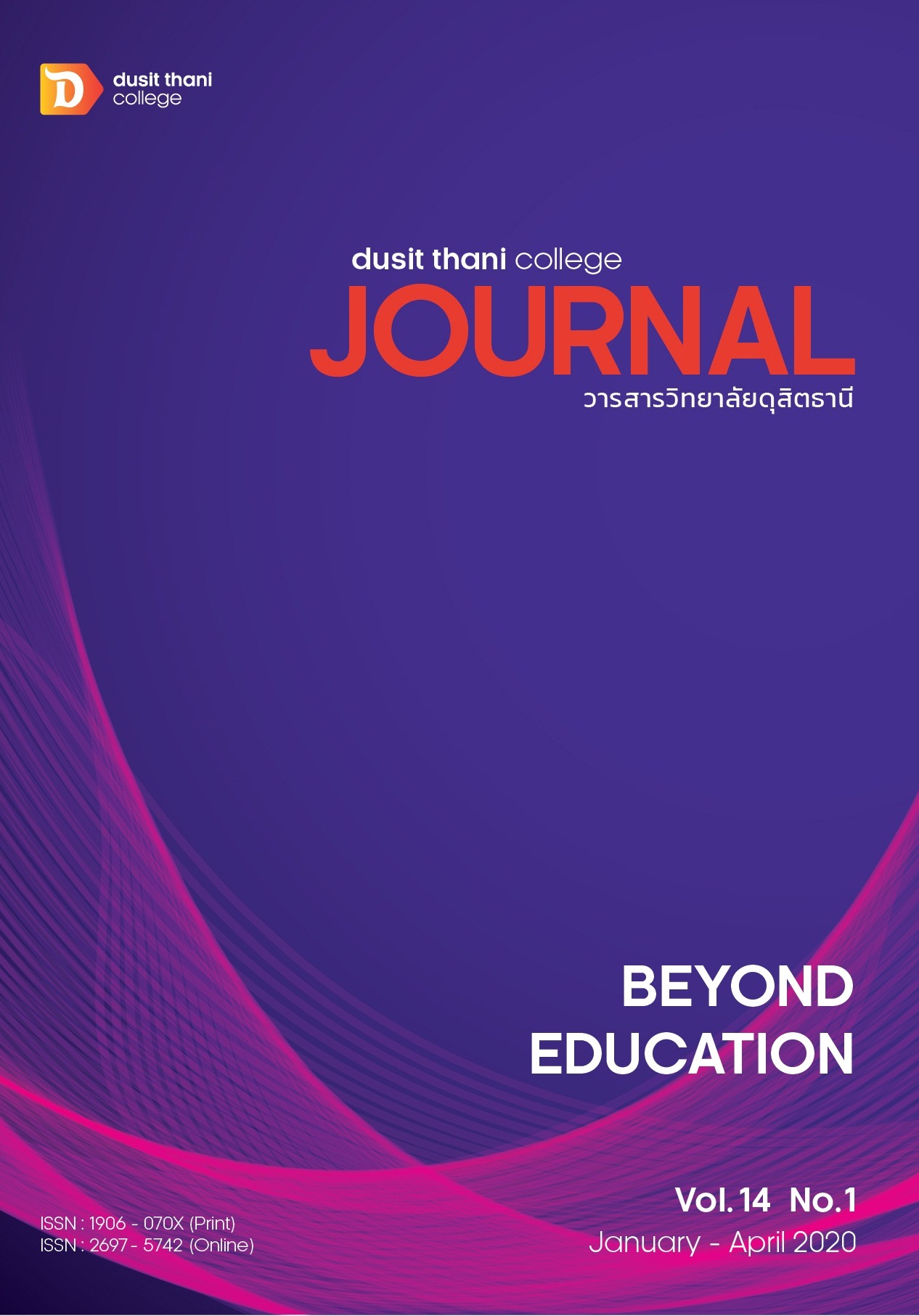Guideline for Development of Service Competencies of Low - cost Airline Ground Staffs: At Phuket International Airport
Main Article Content
Abstract
The objectives of this research were 1) to study the confidence of passengers affecting the service quality of ground receptionists in low cost airlines, 2) to evaluate the competencies for service capabilities of Low Cost Airline Ground Staffs, 3) to be a guideline for developing the capacity of Low Cost Airline Ground Staffs. The sample used in the research was 400 Thai passengers who received services from Low Cost Airline Ground Staffs at Phuket International Airport which was a quantitative research. The statistics used in data analysis were frequency, percentage, arithmetic mean, standard deviation, t-test statistics and One-Way ANOVA.
The research results found that the confidence level in service competencies of Low-Cost Airline Ground Staffs was at high level. When separating two study results from service capability competencies of Low Cost Airline Ground Staffs such as Skills, Knowledge, and Attributes of each staff to work performance, the sample assessed that service capability competencies of Low Cost Airline Ground Staffs s were at high in knowledge and the confidence of passengers affected to the service quality of Low-cost Airline Ground Staffs by 5 SERVQUAL dimensions such as Reliability, Responsiveness, Assurance, Empathy, and Tangibility. When considering each aspect, the sample had the highest confidence in service quality in tangibility. The personal factors such as gender, age and income of the sample affected to the development guideline for service competencies of Low-Cost Airline Ground Staffs differently.
Article Details
Article Screening Policy
- All research and academic articles to be published must be considered and screened by three peer reviews in the relevant field / article.
- All articles, texts, illustrations and tables published in the journal are the personal opinions of the authors. Editors don't always have to agree. And no responsibility whatsoever is the sole responsibility of the author.
- The articles to be published must never be published. Where did you first publish? And not in the consideration of other journals If the audit found that there has been a duplicate publication It is the sole responsibility of the author.
- Any article that the reader sees as being plagiarized or impersonated without reference. Or mislead the work of the author Please let the journal editor know it will be your greatest blessing.
References
2. Airports of Thailand Public Company Limited. (2012). Annual Report 2012. (Online). Accessed from: http://www.airportthai.co.th/ewtadmin85_aot/.../cp_annual_22 Access dates: 12 May 2018.
3. Airports of Thailand Public Company Limited. (2017). Annual Report 2017 Airports of Thailand Public Company Limited. Bangkok: Airports of Thailand Public Company Limited
4. Arphaporn PhuWitthayaphan,2007). Competency Based HRM / HRD Case Study. Bangkok: HR Center Company.
5. Boonlert Chittangwattana (2011). MICE business, organization of business meetings Tourism business as a reward International conferencing business Trade show business. Bangkok: Fern, Governor Printing and Publishing.
6. Civil Aviation Training Center (2012). Summary of Thai aviation industry news, June 2012. (Online) : http://catc.ot.th/2013/attachments/.../year2555/0655.pdf : 8 May 2018.
7. Chanchot Chompunut. (2005). The heart of the service business is dealing with humans. (Online) : http://www.gotoknow.org/posts/409976 Access date: 10 May 2018.
8. Clay, R. (Ed.) (1988). Chambers English Dictionary. Great Britain: Bunay Suffolk.
9. Fitzsimmons, James, A. and Mona, J. (2011). Service Management: Operations, Strategy, Information Technology. (7th ed.). Singapore: McGraw-Hill.
10. Kanlaya Srithi. (2010). Development of the operational capability of the personnel of the subdistrict administration in Ngao District, Lampang Province. Independent Robbery master’s degree, Lampang Rajabhat University
11. Mahasarakrm university. (2012). Service psychology. Maha Sarakham University: Educational Resources Development Center.
12. Moorman, c., Deshpande and Zalman, G. (1993). “Factors affecting trust in market relationships.” Journal of Marketing. 58, (3): 20 - 38.
13. Narongwit Saen Thong. (2004). Let's get to know the Competency. Bangkok: HR Center.
14. Parasuraman, A., Berry, L., and Zeithaml, V. (1991). “Understanding Customer Expectations of Service.” Sloan Management Review. 32, (3) : 39 - 48.
15. Parasuraman, A., Zeithaml, V., Valarie A., and Berry, L. (1988). “SERVQUAL: A Multiple-Item Scale for Measuring Consumer Perceptions of Service Quality.” Journal of Retailing.
16. Siriporn Wissanu Mahimachai (2008). “Proactive for Service Excellence.” Payap University Journal. 21, (1): 1 - 19.
17. Sittichai Sricharoenpramong. (2013). Guidelines for human capital development with Competency Based Learning. Bangkok: National Productivity Institute.
18. Smith Sachchukron. (2007). Excellent hospitality and Service. Bangkok: Saithan.
19. Somchit Satchakorn. (2007). Art of Service. 2nd ed., Bangkok: Saran Than.
20. Supridi Suwannaboon. (2012). Thai language for communication. Suphan Buri: Institute of Physical Education Suphanburi campus.
21. Surachai Promphan. (2011). Dissertation Competency for Competency Development. Bangkok: Intellectual.
22. Yoss Laohasilp Somchit (2010). Thai aviation liberalization policy promotes growth in the aviation industry in the 77th Anniversary, Department of Civil Aviation. 1933 - 2010: Move Thailand to the center of aviation. Bangkok: Department of Civil Aviation.
23. Van de walle, S., and Bouckaert, G. (2003). “Public service performance and trust in Government: the problem of causality.” International Journal of Public Administration. 26, (8-9): 891 - 913.
24. Vroom, H. V. (1964). Work and Motivation. New York: Wiley and Sons.
25. Watcharaphon Suraphi and Chalong Sripimon Sompong. (2013). “A Study of Competency Needs of Personnel in the Conference Industry Exhibition and tourism as a reward for Thailand.” Journal of Business Administration Economics and Communication.
26. Yamane, T. (1973). Statistics: An Introductory Analysis. (3th ed.). New York : Harper and Row Publication.


